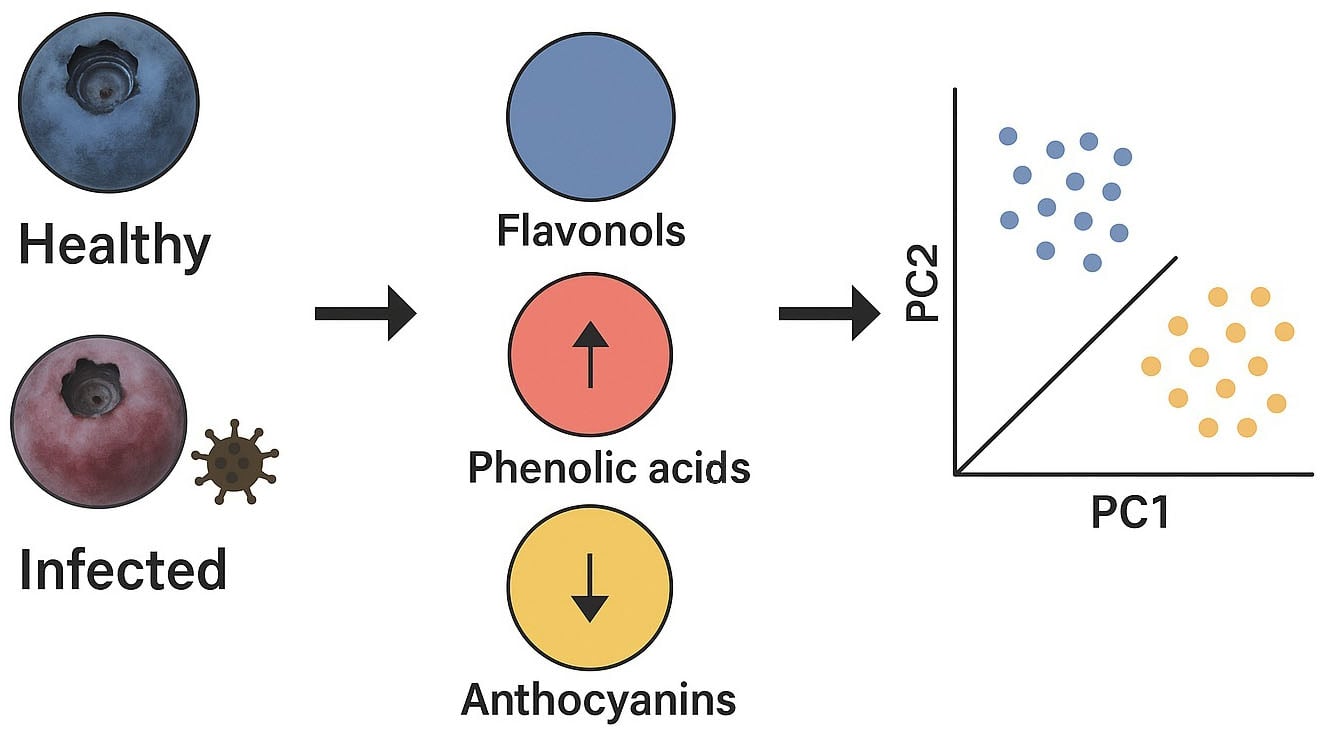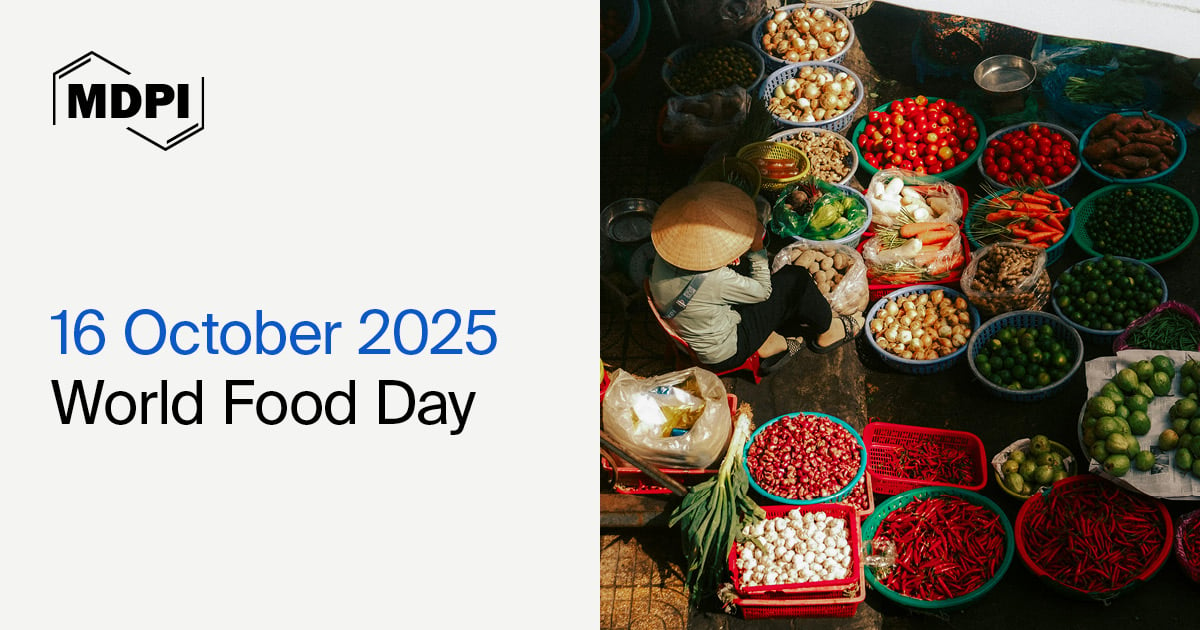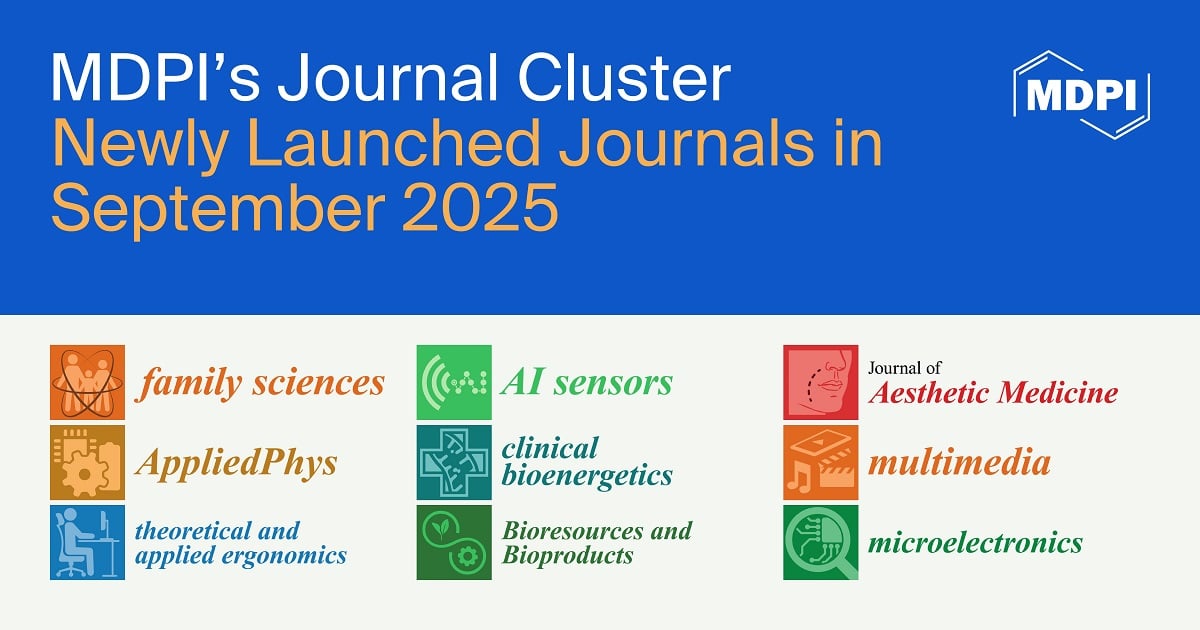-
 Manganese Superoxide Dismutase: Structure, Function, and Implications in Human Disease
Manganese Superoxide Dismutase: Structure, Function, and Implications in Human Disease -
 Oxidative Stress in the Pathophysiology of Chronic Venous Disease
Oxidative Stress in the Pathophysiology of Chronic Venous Disease -
 Inhibitory Infrared Light Restores Mitochondrial Homeostasis in an Oxygen–Glucose Deprivation/Reoxygenation Model
Inhibitory Infrared Light Restores Mitochondrial Homeostasis in an Oxygen–Glucose Deprivation/Reoxygenation Model -
 In Silico and In Vitro Analysis of Synergistic Bioactivities of Morus alba and Pinus densiflora Extracts with Methyl Gallate
In Silico and In Vitro Analysis of Synergistic Bioactivities of Morus alba and Pinus densiflora Extracts with Methyl Gallate
Journal Description
Antioxidants
Antioxidants
is an international, peer-reviewed, open access journal, published monthly online by MDPI. The International Coenzyme Q10 Association (ICQ10A), Israel Society for Oxygen and Free Radical Research (ISOFRR) and European Academy for Molecular Hydrogen Research (EAMHR) are affiliated with Antioxidants and their members receive discounts on the article processing charge.
- Open Access— free for readers, with article processing charges (APC) paid by authors or their institutions.
- High Visibility: indexed within Scopus, SCIE (Web of Science), PubMed, PMC, FSTA, PubAg, CAPlus / SciFinder, and other databases.
- Journal Rank: JCR - Q1 (Chemistry, Medicinal) / CiteScore - Q1 (Food Science)
- Rapid Publication: manuscripts are peer-reviewed and a first decision is provided to authors approximately 17.4 days after submission; acceptance to publication is undertaken in 2.4 days (median values for papers published in this journal in the first half of 2025).
- Recognition of Reviewers: reviewers who provide timely, thorough peer-review reports receive vouchers entitling them to a discount on the APC of their next publication in any MDPI journal, in appreciation of the work done.
- Testimonials: See what our editors and authors say about Antioxidants.
- Companion journal: Oxygen.
Impact Factor:
6.6 (2024);
5-Year Impact Factor:
7.3 (2024)
Latest Articles
Influence of Blueberry Mosaic Disease on Polyphenolic Profile and Antioxidant Capacity of Highbush Blueberry ‘Duke’ Fruits
Antioxidants 2025, 14(11), 1302; https://doi.org/10.3390/antiox14111302 - 29 Oct 2025
Abstract
Blueberry mosaic virus (BlMaV) is a persistent pathogen that alters host physiology; however, its impact on secondary metabolism in blueberry fruits remains poorly characterized. In this study, the phenolic profile of the cultivar ‘Duke’ was systematically examined in healthy and BlMaV-infected plants over
[...] Read more.
Blueberry mosaic virus (BlMaV) is a persistent pathogen that alters host physiology; however, its impact on secondary metabolism in blueberry fruits remains poorly characterized. In this study, the phenolic profile of the cultivar ‘Duke’ was systematically examined in healthy and BlMaV-infected plants over two successive years. Using UHPLC Q-ToF MS, a total of 46 phenolic compounds were detected, spanning flavonols, phenolic acids, and anthocyanins. Comparative analyses revealed consistent shifts in metabolite abundance between healthy and infected samples. Several flavonol aglycones and phenolic acid derivatives accumulated in infected fruits, whereas multiple anthocyanins and glycosides were reduced. To further explore metabolic relationships, color correlation analysis highlighted distinct co-variation patterns among compound classes. Principal component analysis clearly separated infected and healthy fruits, confirming that viral infection was the dominant source of variation, surpassing the influence of harvest year or environmental factors. Nevertheless, the antioxidant capacity remained unchanged, regardless of the presence of the virus or the variation in environmental conditions. These results provide novel biochemical evidence that BlMaV infection reshapes the phenolic composition of blueberries and lays the groundwork for future studies on the metabolic consequences of viral stress in fruit crops.
Full article
(This article belongs to the Special Issue Bioactive Compounds and Antioxidants in Fruits and Vegetables—2nd Edition)
►
Show Figures
Open AccessArticle
Shikonin-Loaded Nanoparticles Attenuate Particulate Matter-Induced Skin Injury by Inhibiting Oxidative Stress and Inflammation
by
Feifei Huang, Qinghua Tang, Ke Wang, Lingmei Zhou, Ruiwei Liao, Zhuoya Wang, Yan Li, Lin Zhou and Ming Li
Antioxidants 2025, 14(11), 1301; https://doi.org/10.3390/antiox14111301 - 29 Oct 2025
Abstract
Exposure to fine particulate matter (PM2.5) poses a major threat to skin health, yet effective prevention strategies remain limited. Shikonin, a naphthoquinone derived from Lithospermum erythrorhizon, exhibits potent antioxidant and anti-inflammatory activities. However, its therapeutic application is limited by low bioavailability. To address
[...] Read more.
Exposure to fine particulate matter (PM2.5) poses a major threat to skin health, yet effective prevention strategies remain limited. Shikonin, a naphthoquinone derived from Lithospermum erythrorhizon, exhibits potent antioxidant and anti-inflammatory activities. However, its therapeutic application is limited by low bioavailability. To address this limitation, we developed shikonin-loaded nanoparticles (SH-NPs) using an emulsion solvent evaporation method and characterized their physicochemical properties. The protective effects of SH-NPs against PM2.5-induced skin damage were evaluated in a mouse model. The SH-NPs exhibited favorable characteristics, including a mean particle size of 209.03 ± 2.45 nm, a PDI of 0.064 ± 0.03, and a zeta potential of –17.69 ± 2.06 mV. The encapsulation efficiency is 88% and the drug loading capacity is 5.5%, respectively. In vitro, SH-NPs significantly enhanced cellular uptake in HaCaT cells. In vivo, treatment with SH-NPs significantly improved skin structural disorders, epidermal thickening, and collagen fiber reduction, while downregulating the expression of MMP-2 and MMP-9. Furthermore, SH-NPs increased the expression of SOD1 and SOD2, reduced MDA levels, and decreased the expression of TNF-α, IL-1β, and NO. In conclusion, SH-NPs attenuated PM2.5-induced skin toxicity via enhanced antioxidant, anti-inflammatory, and anti-degradation mechanisms, offering a novel strategy to boost shikonin bioavailability and prevent PM2.5-related skin damage.
Full article
(This article belongs to the Section Health Outcomes of Antioxidants and Oxidative Stress)
►▼
Show Figures
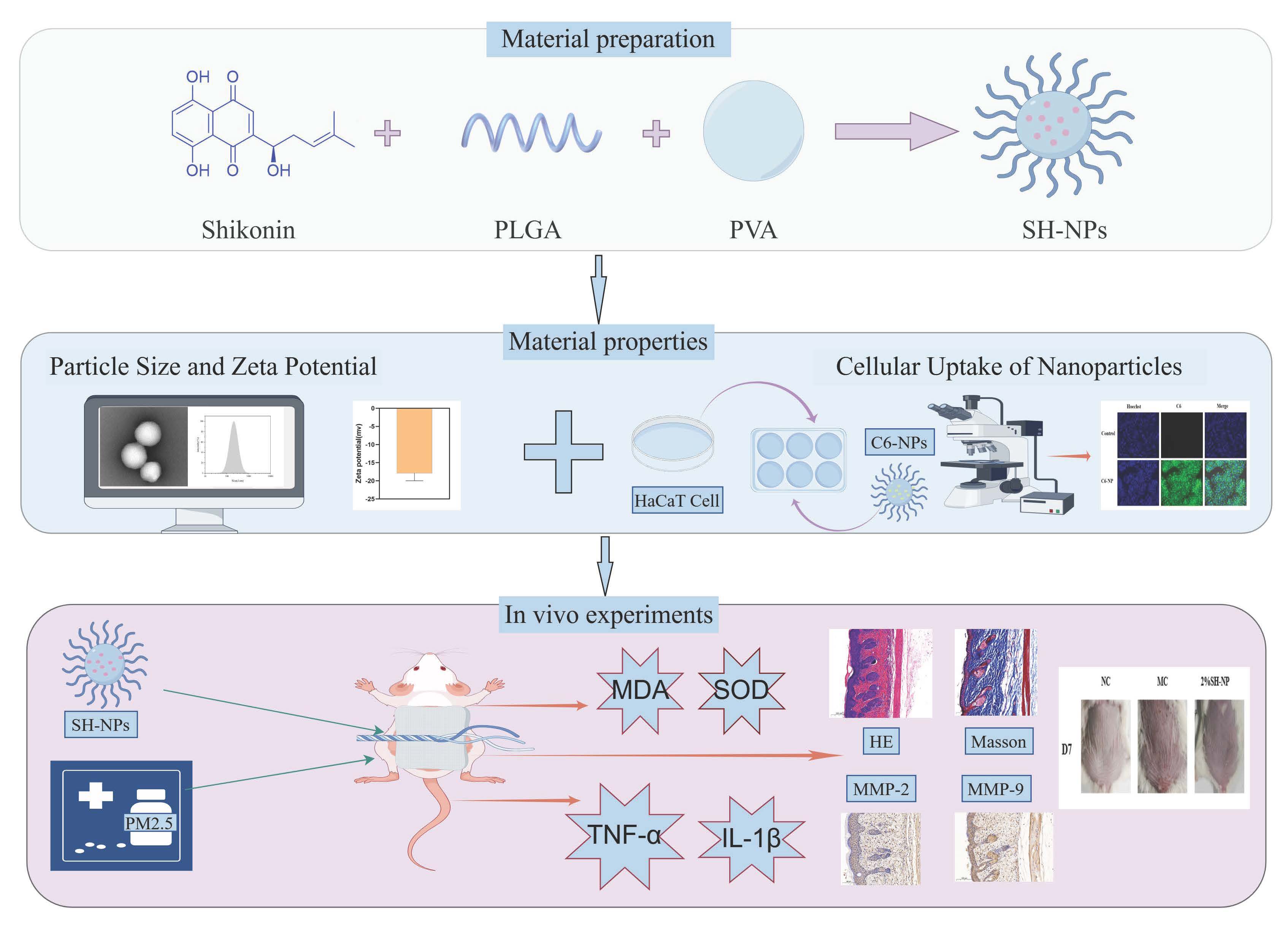
Graphical abstract
Open AccessArticle
Resveratrol Alleviates Effects of LPS on Estrogen Synthesis, Oxidative Stress, Inflammation, and Pyroptosis of Goat Granulosa Cells by Activating the PPARG/NRF2/HO-1 Signaling Pathway
by
Jie Zhao, Xianyi Zhou, Zhen Cang, Xin Liu, Muhammad Tariq and Dagan Mao
Antioxidants 2025, 14(11), 1300; https://doi.org/10.3390/antiox14111300 - 29 Oct 2025
Abstract
This study aims to investigate the effect and mechanism of resveratrol (RES) on lipopolysaccharide (LPS)-induced injury in goat granulosa cells (GCs). First, the appropriate time and concentration were screened for LPS (4 μg/mL, 12 h), RES (1 μM, 6 h), and GW9662 (an
[...] Read more.
This study aims to investigate the effect and mechanism of resveratrol (RES) on lipopolysaccharide (LPS)-induced injury in goat granulosa cells (GCs). First, the appropriate time and concentration were screened for LPS (4 μg/mL, 12 h), RES (1 μM, 6 h), and GW9662 (an antagonist of PPARG, 1 μM, 12 h) through CCK8 and RT-qPCR. Then, cells were treated with LPS, RES, or/and GW9662, to examine steroidogenesis, inflammation, oxidative stress, and pyroptosis by RIA, RT-qPCR, WB, flow cytometry, and IF, respectively. Results showed that RES inhibited LPS-induced increases in MDA content, ROS production, gene expressions of IL-1β, NLRP3, Caspase1, and GSDMD, as well as protein levels of IL-1β, and GSDMD, accompanied by decreases in SOD activity, T-AOC and E2 content, gene expressions of SOD, CYP19A1, and HSD3B, and protein levels of SOD and HSD3B. Furthermore, RES inhibited LPS-induced decreases in PPARG, NRF2, and HO-1 gene expressions and protein levels. However, GW9662 could block all the alleviating effects of RES on LPS. In conclusion, RES regulates the effects of LPS on hormone secretion, inflammation, oxidative stress, and pyroptosis by modulating the PPARG/NRF2/HO-1 pathway, providing a new theoretical basis for improving goat reproduction.
Full article
(This article belongs to the Special Issue Antioxidant Effects of Natural Compounds on Cell Metabolism)
►▼
Show Figures
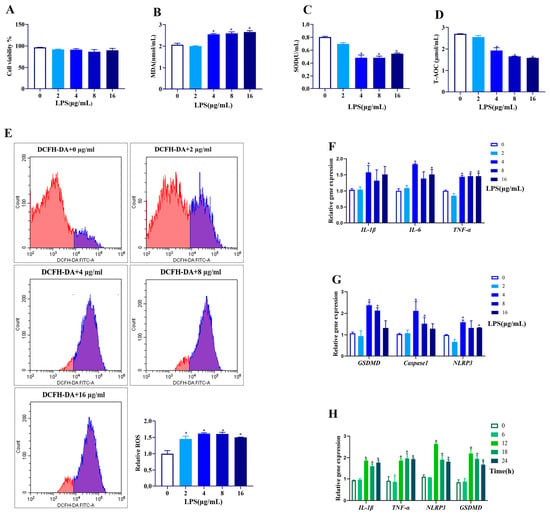
Figure 1
Open AccessReview
Selenium: A Key Element in Inflammatory Bowel Disease
by
Francesca Gorini and Alessandro Tonacci
Antioxidants 2025, 14(11), 1299; https://doi.org/10.3390/antiox14111299 - 29 Oct 2025
Abstract
Inflammatory bowel disease (IBD) is a multifactorial and complex condition of the gastrointestinal tract shaped by host genetics, immune dysregulation, gut microbiota and environmental determinants, with a steadily rising global prevalence. Although the etiology of IBD remains incompletely understood, chronic inflammation accompanied by
[...] Read more.
Inflammatory bowel disease (IBD) is a multifactorial and complex condition of the gastrointestinal tract shaped by host genetics, immune dysregulation, gut microbiota and environmental determinants, with a steadily rising global prevalence. Although the etiology of IBD remains incompletely understood, chronic inflammation accompanied by oxidative stress, immune dysregulation, and gut dysbiosis is widely recognized as a hallmark of the condition. Given the frequent occurrence of undernutrition in IBD patients, the role of vitamins and micronutrients in modulating disease activity has been recently explored. Selenium (Se) is universally recognized as an essential trace element due to its diverse physiological functions, including potent antioxidant activity, anti-inflammatory effects, immunomodulatory properties, and the ability to influence gut microbial composition and diversity. This comprehensive review examines current evidence on the relationship between Se status and IBD, integrating epidemiological and experimental findings, elucidating the underlying biological mechanisms, and introducing Se nanoparticles, a viable therapeutic option using Se in IBD management.
Full article
(This article belongs to the Special Issue Antioxidants as Adjuvants for Inflammatory Bowel Disease Treatment)
►▼
Show Figures
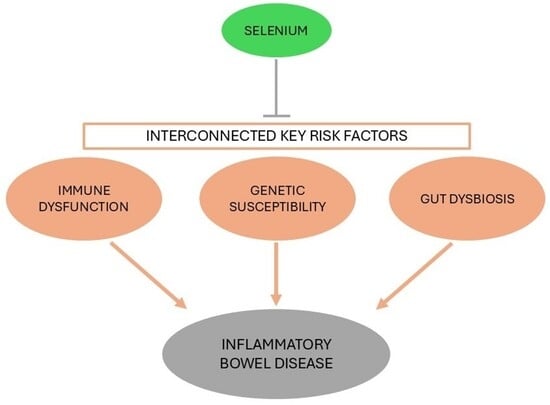
Graphical abstract
Open AccessArticle
Dimerocostus strobilaceus (Caña Agria) as an Emerging Reservoir of Bioactive Metabolites with Potential Antioxidant, Antimicrobial, Anticancer and Anti-Inflammatory Health Benefits
by
Elena Coyago-Cruz, Rebeca Gonzalez-Pastor, Gabriela Méndez, Jeico Usinia-Carranza, Juan A. Puente-Pineda, Johana Zúñiga-Miranda, Marco Cerna and Jorge Heredia-Moya
Antioxidants 2025, 14(11), 1298; https://doi.org/10.3390/antiox14111298 - 29 Oct 2025
Abstract
The Amazon region is home to a wide variety of plant species that are of interest for their medicinal and nutritional properties. This study aimed to evaluate the physicochemical properties, bioactive compound profile, and antioxidant, antimicrobial, anticancer and anti-inflammatory activity of Dimerocostus strobilaceus
[...] Read more.
The Amazon region is home to a wide variety of plant species that are of interest for their medicinal and nutritional properties. This study aimed to evaluate the physicochemical properties, bioactive compound profile, and antioxidant, antimicrobial, anticancer and anti-inflammatory activity of Dimerocostus strobilaceus leaves, stems, and seeds. Vitamin C, organic acids, carotenoids, and phenolic compounds were quantified using RPLC. Antioxidant activity was determined using ABTS and DPPH, while antimicrobial activity was assessed against pathogenic and multidrug-resistant bacteria. Anticancer activity was evaluated in tumour cell lines (HeLa, HCT116, HepG2, and THJ29T), and anti-inflammatory activity was examined in RAW 264.7 macrophages. The seeds stood out for their content of ferulic, caffeic and chlorogenic acids, while kaempferol and quercetin predominated in the leaves. The leaves exhibited greater antimicrobial efficacy and antiproliferative activity (IC50 < 0.2 mg/mL), albeit with limited selectivity. These findings suggest that ‘caña agria’ is a promising source of bioactive metabolites with biotechnological and therapeutic applications.
Full article
(This article belongs to the Special Issue Bioactive Compounds: Antioxidant, Antibacterial, Anti-inflammatory Modulation)
►▼
Show Figures
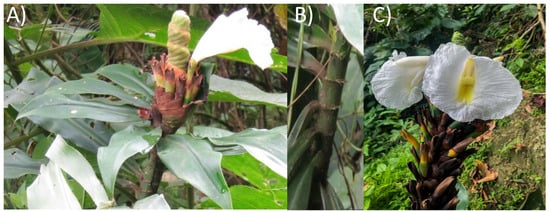
Figure 1
Open AccessArticle
Investigation into Bioactive Selenium Species and the Mechanism of Action Behind Selenium-Enriched Rapeseed Flowering Stalks Alleviating Cadmium-Induced Toxicity in Mouse Sertoli Cells
by
Huatao Che, Yiqing Lu, Tong Li, Xiaoli Fang, Xinfa Wang, Hanzhong Wang, Xiaoling Dun and Zhenna Chen
Antioxidants 2025, 14(11), 1297; https://doi.org/10.3390/antiox14111297 - 28 Oct 2025
Abstract
Cadmium (Cd) is a recognized environmental contaminant, present in soil, water, and food, which has been reported to cause male reproductive damage in vivo and vitro. Selenium-enriched rapeseed flowering stalks exhibit protective effects against Cd-induced reproductive damage, yet the bioactive components and underlying
[...] Read more.
Cadmium (Cd) is a recognized environmental contaminant, present in soil, water, and food, which has been reported to cause male reproductive damage in vivo and vitro. Selenium-enriched rapeseed flowering stalks exhibit protective effects against Cd-induced reproductive damage, yet the bioactive components and underlying mechanisms remain unclear. We optimized the process of obtaining the crude extract (CE) via single-factor experiments. Subsequent bioassay-guided fractionation identified the water extract (WE) as significantly more effective in alleviating Cd-induced cytotoxicity compared to the petroleum ether extract, ethyl acetate extract, and n-butanol extract. High-performance liquid chromatography–inductively coupled plasma mass spectrometry (HPLC-ICP-MS) analysis revealed that WE contained the highest contents of methylselenocysteine (MeSeCys) and selenocystine (SeCys2) among four fractions. Both MeSeCys and SeCys2 exhibited protective effects against Cd-induced cytotoxicity. To further elucidate the underlying mechanisms, network pharmacology, RNA-Seq, qPCR, and Western blotting analysis were employed. The results revealed that WE exhibited good free radical scavenging capabilities, and the protective mechanisms of WE, MeSeCys, and SeCys2 against Cd-induced cytotoxicity were related to a reduction in oxidative damage, the inhibition of the ERK/p38 MAPK signaling pathway, and the suppression of cell cycle arrest, inflammation, and apoptosis triggered by Cd exposure. Collectively, these findings suggest that selenium-enriched rapeseed flowering stalks may serve as a promising dietary supplement in the prevention of Cd-induced reproductive toxicity.
Full article
(This article belongs to the Section Extraction and Industrial Applications of Antioxidants)
►▼
Show Figures

Graphical abstract
Open AccessArticle
Scorpion Venom Heat-Resistant Synthetic Peptide Alleviates DSS-Induced Colitis via α7nAChR-Mediated Modulation of the JAK2/STAT3 Pathway
by
Kang Cheng, Guangbo He, Xiaxia Li, Yuqian Li, Xiaolin Cui, Xuefei Wu, Jau-Shyong Hong, Jie Zhao, Sheng Li and Yanjie Guo
Antioxidants 2025, 14(11), 1296; https://doi.org/10.3390/antiox14111296 - 28 Oct 2025
Abstract
Background: Inflammatory bowel disease (IBD) is a chronic relapsing inflammatory disorder with limited treatment options. Emerging evidence reveals bidirectional crosstalk between gut and brain through inflammatory signaling, leading us to hypothesize that anti-neuroinflammatory agents may concurrently ameliorate intestinal inflammation. The scorpion venom-derived heat-resistant
[...] Read more.
Background: Inflammatory bowel disease (IBD) is a chronic relapsing inflammatory disorder with limited treatment options. Emerging evidence reveals bidirectional crosstalk between gut and brain through inflammatory signaling, leading us to hypothesize that anti-neuroinflammatory agents may concurrently ameliorate intestinal inflammation. The scorpion venom-derived heat-resistant synthetic peptide (SVHRSP), a bioactive peptide initially identified in scorpion venom and subsequently synthesized by our laboratory, possesses neuroprotective, anti-inflammatory, and antioxidative activities. Its properties make SVHRSP a promising candidate for investigating the therapeutic potential of anti-neuroinflammatory strategies in mitigating intestinal inflammation. Methods: Using a chronic dextran sodium sulfate (DSS)-induced colitis model in wild-type and α7 nicotinic acetylcholine receptor (α7nAChR) knockout mice, along with lipopolysaccharide (LPS)-stimulated RAW264.7 macrophages, we assessed SVHRSP’s effects on inflammation, histopathology, gut permeability, oxidative stress markers, and α7nAChR-Janus kinase 2 (JAK2)/signal transducer and activator of transcription 3 (STAT3) signaling. Results: SVHRSP treatment significantly ameliorated colitis symptoms in wild-type mice by reducing inflammation, repairing histological damage, restoring gut barrier function, and attenuating oxidative stress, with these effects abolished in α7nAChR knockout mice. Mechanistically, SVHRSP activated JAK2/STAT3 signaling through α7nAChR engagement, suppressing proinflammatory cytokine production in macrophages. Conclusion: These results demonstrated that SVHRSP alleviated intestinal inflammation via α7nAChR-dependent JAK2/STAT3 activation. Combined with its known neuroprotective properties, our findings support the repurposing of this neuroactive peptide, SVHRSP, for treating intestinal inflammatory disorders.
Full article
(This article belongs to the Section Health Outcomes of Antioxidants and Oxidative Stress)
►▼
Show Figures
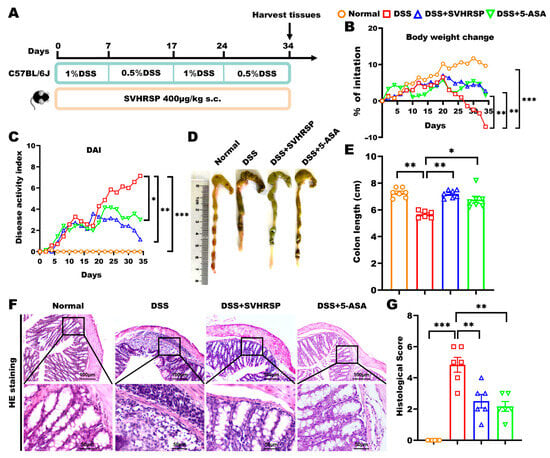
Figure 1
Open AccessReview
Lung Ischemia–Reperfusion Injury in Lung Transplant Surgery: Where Do We Stand?
by
Lawek Berzenji, Jeroen M. H. Hendriks, Stijn E. Verleden, Suresh Krishan Yogeswaran, Wen Wen, Patrick Lauwers, Geert Verleden, Rudi De Paep, Pieter Mertens, Inez Rodrigus, Dirk Adriaensen and Paul Van Schil
Antioxidants 2025, 14(11), 1295; https://doi.org/10.3390/antiox14111295 - 28 Oct 2025
Abstract
Lung ischemia–reperfusion injury (LIRI) remains a major contributor to perioperative morbidity and mortality in thoracic surgery, especially for lung transplantations, where it is one of the principal drivers of primary graft dysfunction (PGD). Although substantial advances have been made in surgical technique, donor
[...] Read more.
Lung ischemia–reperfusion injury (LIRI) remains a major contributor to perioperative morbidity and mortality in thoracic surgery, especially for lung transplantations, where it is one of the principal drivers of primary graft dysfunction (PGD). Although substantial advances have been made in surgical technique, donor management, and perioperative care, LIRI continues to pose a significant clinical challenge. Mechanistically, LIRI reflects a combined pathology of oxidative stress, endothelial and glycocalyx disruption, innate immune activation, mitochondrial dysfunction, and regulated cell death, resulting in loss of alveolar–capillary barrier integrity and gas exchange failure. Current management is phase-specific and multimodal, spanning donor care and preservation, controlled reperfusion and lung-protective ventilation, and pharmacological treatments. Treatment candidates that target oxidative stress and inflammatory cascades (e.g., antioxidants, complement and adenosine pathways, mesenchymal stromal cell products, and dipeptidyl-peptidase-4 inhibition) show promise, yet translation into a clinical scenario remains difficult. Increasing evidence supports endothelial-preserving and mitochondria-sparing strategies, rigorous perioperative bundles, and biomarker-guided trials to move from pathophysiology to practice. Ultimately, addressing LIRI requires an integrated, multidisciplinary approach that spans surgical, anesthetic, and pharmacologic domains, with the goal of improving both early outcomes and long-term graft survival in lung transplant patients.
Full article
(This article belongs to the Special Issue New Strategies in Preventing Inflammatory and/or Oxidative Stress-Induced Damages in Ischemia-Reperfusion Injury, 2nd Edition)
►▼
Show Figures

Figure 1
Open AccessArticle
Protective Role of Spermidine Against Diabetes-Induced Ovarian and Endometrial Injury via LC3 and Beclin-1 Modulation
by
Bakiye Akbaş, Gülseren Dinç, Ahmet Akbaş, Nadir Adnan Hacım, Gülçin Ercan, Hatice Aygün and Oytun Erbaş
Antioxidants 2025, 14(11), 1294; https://doi.org/10.3390/antiox14111294 - 28 Oct 2025
Abstract
Background: Diabetes mellitus adversely affects female reproductive health by inducing oxidative stress, impairing autophagy, and promoting fibrotic remodeling in ovarian and uterine tissues. Spermidine, a natural polyamine, has gained attention as an antioxidant and autophagy enhancer. This study aimed to investigate the potential
[...] Read more.
Background: Diabetes mellitus adversely affects female reproductive health by inducing oxidative stress, impairing autophagy, and promoting fibrotic remodeling in ovarian and uterine tissues. Spermidine, a natural polyamine, has gained attention as an antioxidant and autophagy enhancer. This study aimed to investigate the potential protective role of spermidine against diabetes-induced reproductive injury in rats. Methods: Thirty adult female Wistar rats were randomly divided into three groups (n = 10 each): Control, Diabetes, and Diabetes + Spermidine. Diabetes was induced with streptozotocin (60 mg/kg, i.p.). After confirmation of hyperglycemia (≥250 mg/dL), rats received either saline or spermidine (40 mg/kg/day, oral gavage) for four weeks. At sacrifice, plasma anti-Müllerian hormone (AMH) levels were determined, and ovarian and uterine tissues were assessed histologically and biochemically for oxidative stress markers (GSH, MDA, Nrf2), autophagy proteins (LC3, Beclin-1), and fibrosis indicators (TGF-β, histological scoring). Results: Diabetic rats exhibited severe hyperglycemia, pronounced follicular and endometrial degeneration, increased fibrosis, reduced plasma AMH, depleted GSH, SOD, CAT, GPx and Nrf2, and elevated MDA (p < 0.001). Spermidine treatment significantly mitigated these alterations, lowering glucose levels, alleviating histopathological injury, elevating the antioxidant defense (GSH, SOD, CAT, GPx) and the Nrf2 and decreasing MDA and TGF-β concentrations (p < 0.05 vs. Diabetes). Moreover, spermidine supplementation enhanced LC3 and Beclin-1 expression, suggesting improved autophagic activity. Conclusions: Spermidine counteracts diabetes-induced ovarian and uterine damage by reinforcing antioxidant defense, stimulating autophagy, and limiting fibrosis. These findings highlight spermidine as a promising adjunctive agent to support female reproductive health under diabetic conditions.
Full article
(This article belongs to the Section Health Outcomes of Antioxidants and Oxidative Stress)
►▼
Show Figures
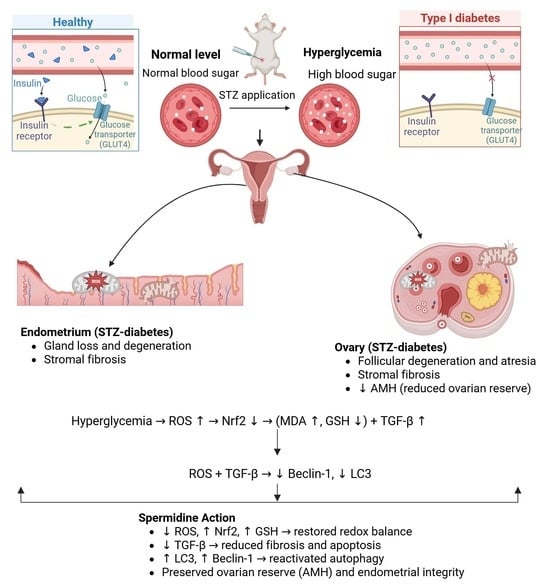
Graphical abstract
Open AccessArticle
Optimization of Polyphenol-Rich Extracts from Defatted Avocado Peel and Seed Residues Using Ultrasound-Assisted RSM: Antioxidant Potential and Valorization Prospects
by
Argyro Petrantonaki, Vasiliki-Ioanna Theodoropoulou, Martha Mantiniotou, Vassilis Athanasiadis, Eleni Bozinou and Stavros I. Lalas
Antioxidants 2025, 14(11), 1293; https://doi.org/10.3390/antiox14111293 - 28 Oct 2025
Abstract
It is well known that a significant amount of processed avocado fruit, specifically peel and seed, is treated as waste. During this study, these by-products were valorized through a two-step approach combining lipid profiling and optimized antioxidant extraction. Initially, oil was extracted and
[...] Read more.
It is well known that a significant amount of processed avocado fruit, specifically peel and seed, is treated as waste. During this study, these by-products were valorized through a two-step approach combining lipid profiling and optimized antioxidant extraction. Initially, oil was extracted and analyzed via GC-FID, revealing distinct fatty acid compositions: peel oil was rich in oleic (32.0%), linoleic (21.9%), and α-linolenic acids (9.7%), while seed oil was dominated by oleic (48.0%) and palmitic acids (20.7%), with moderate linoleic content (24.0%). Following defatting, the dried residues were subjected to ultrasound-assisted extraction, which was optimized by response surface methodology (RSM) to maximize the recovery of antioxidant-rich fractions. Peel extracts exhibited the highest total polyphenolic content (105.98 mg GAE/g), FRAP (673.89 μmol AAE/g), and ascorbic acid (17.9 mg/g), while seed extracts showed superior DPPH activity (1071.31 μmol AAE/g). Regression modeling identified optimal conditions for each antioxidant metric, highlighting matrix-specific bioactivity. The combined analysis of lipid and polar fractions underscores the multifunctional potential of avocado residues as sustainable sources of natural antioxidants. These findings support their application in food, cosmetic, and nutraceutical formulations, contributing to circular bioeconomy strategies.
Full article
(This article belongs to the Special Issue Bioactive Antioxidants from Agri-Food Wastes)
►▼
Show Figures
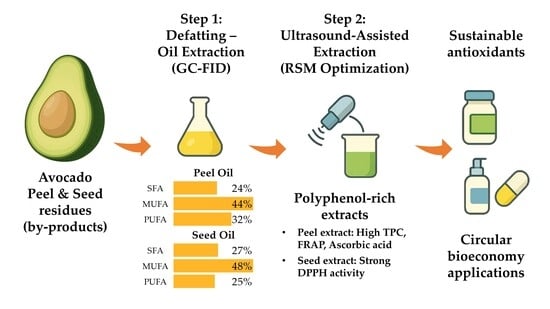
Graphical abstract
Open AccessArticle
Differential Expression of Antioxidant and Oxidant Pathways in Chronic Rhinosinusitis Without Nasal Polyps
by
Yih-Jeng Tsai, Jiunn-Min Shieh, Ming-Chieh Ma and Wen-Bin Wu
Antioxidants 2025, 14(11), 1292; https://doi.org/10.3390/antiox14111292 - 28 Oct 2025
Abstract
Chronic rhinosinusitis without nasal polyps (CRSsNP) is a chronic inflammatory disease that lacks a clear pathogenesis/pathophysiology. While large studies focused on elucidating the pathophysiology of CRS with NPs (CRSwNP), this study aimed to use a systemic evaluation approach to identify the redox gene
[...] Read more.
Chronic rhinosinusitis without nasal polyps (CRSsNP) is a chronic inflammatory disease that lacks a clear pathogenesis/pathophysiology. While large studies focused on elucidating the pathophysiology of CRS with NPs (CRSwNP), this study aimed to use a systemic evaluation approach to identify the redox gene expression profile, its association with oxidative damage in CRSsNP, and the differences between CRSsNP and -wNP. The expression of 84 redox genes was analyzed using real-time PCR array in control and CRSsNP nasal mucosae. Changes in the mRNA and protein levels of these redox differentially expressed genes (DEGs) were verified using a customized real-time PCR array, RT-PCR, and Western blotting in an additional 18 patients. 4-Hydroxynonenal (lipid peroxidation) and 3-nitrotyrosine (protein nitrosylation) expression, representing oxidative stress (OxS) and nitrosative stress (NsS) status, were examined using immunohistochemistry. We found 27 DEGs (24 upregulated and 3 downregulated) in CRSsNP. AKR1C2, GCLM, GPX2, NOS2, and NQO1 were upregulated and LPO was downregulated more than 4-fold. These changes led to a substantial increase in OxS in CRSsNP nasal mucosa. In a comparison of the currently identified 27 DEGs with the 23 previously reported CRSwNP genes, there were 16 unique redox DEGs expressed between CRSsNP and -wNP. A String protein interaction network analysis revealed that CRSsNP possessed “an adaptive antioxidant defense signature”, while CRSwNP showed “a pro-inflammatory and -oxidant pathway”. Collectively, we systemically performed transcriptomic analysis to profile OxS-related genes in CRSsNP and highlighted the unique redox gene sets and pathway differences between CRSsNP and -wNP.
Full article
(This article belongs to the Special Issue Antioxidants and Antioxidant Mechanisms in the Prevention and Treatment of Infectious Diseases)
►▼
Show Figures

Figure 1
Open AccessArticle
BKS-112, a Selective Histone Deacetylase 6 Inhibitor, Suppresses Triple-Negative Breast Cancer Cells via AKT/mTOR Pathway
by
Sreevarsha Gali, Swati Sharma, Hyunji Noh, In Su Kim and Hyung Sik Kim
Antioxidants 2025, 14(11), 1291; https://doi.org/10.3390/antiox14111291 - 28 Oct 2025
Abstract
Triple-negative breast cancer (TNBC) remains a leading cause of cancer-related mortality in women, characterized by its aggressive nature and limited therapeutic options. TNBC is defined by the absence of estrogen receptor (ER), progesterone receptor (PR), and human epidermal growth factor receptor 2 (HER2)
[...] Read more.
Triple-negative breast cancer (TNBC) remains a leading cause of cancer-related mortality in women, characterized by its aggressive nature and limited therapeutic options. TNBC is defined by the absence of estrogen receptor (ER), progesterone receptor (PR), and human epidermal growth factor receptor 2 (HER2) expression, which excludes patients from targeted endocrine and HER2-directed therapies, contributing to poor prognosis. This study investigates BKS-112, a potent histone deacetylase 6 (HDAC6) inhibitor, for its anticancer activity against TNBC using MDA-MB-231 cells. We assessed HDAC protein expression and their prognostic implications, alongside in vitro experiments analyzing cell viability, apoptosis, autophagy, and colony formation. BKS-112 exhibited dose- and time-dependent reductions in cell viability, significant morphological alterations, and decreased colony formation. The compound increased the acetylation of histones H3, H4, and α-tubulin while downregulating HDAC6 expression and activity. Additionally, BKS-112 reduced cell migration, demonstrating anti-metastatic potential. It induced G1 phase cell cycle arrest and modulated key regulators, including cyclins and cyclin-dependent kinases (CDKs). Apoptosis was promoted through mitochondrial pathways, evidenced by changes in Bcl-2, Bax, and caspase activation. BKS-112 also elevated reactive oxygen species (ROS) levels, affecting apoptosis-related PI3K/AKT signaling. Autophagy was triggered by upregulating LC3 and Atg-7 expression. Collectively, these findings suggest that BKS-112 exerts robust anticancer effects by inducing cell cycle arrest, apoptosis, and autophagy, highlighting its therapeutic promise for TNBC treatment.
Full article
(This article belongs to the Section Extraction and Industrial Applications of Antioxidants)
►▼
Show Figures
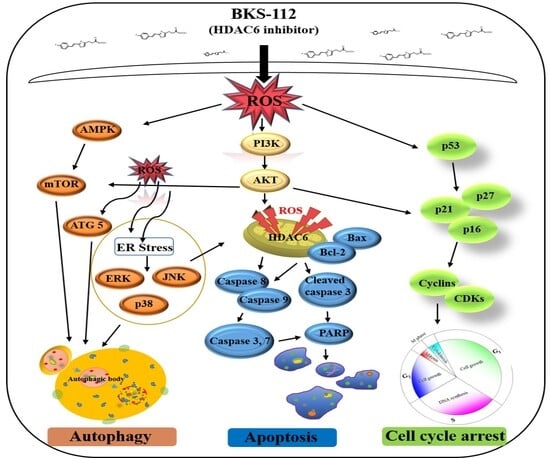
Graphical abstract
Open AccessEditorial
Methodologies for Improving Antioxidant Properties and Absorption: 1st Edition
by
Daniela Tofani
Antioxidants 2025, 14(11), 1290; https://doi.org/10.3390/antiox14111290 - 28 Oct 2025
Abstract
In recent decades, biological and biochemical research has greatly advanced our understanding of the significant effects of many natural antioxidants on various pathologies and diseases [...]
Full article
(This article belongs to the Special Issue Methodologies for Improving Antioxidant Properties and Absorption)
Open AccessReview
Cancer-Related Malnutrition and Oxidative Stress in Colorectal Cancer Surgery: A Narrative Review of Pathophysiology and Postoperative Outcomes
by
Andrii Zahorodnii, Alicja Jelska, Paulina Głuszyńska and Hady Razak Hady
Antioxidants 2025, 14(11), 1289; https://doi.org/10.3390/antiox14111289 - 28 Oct 2025
Abstract
Colorectal cancer (CRC) is a major global health concern with high morbidity and mortality, particularly complicated by postoperative complications. This narrative review explores the interplay between cancer-related malnutrition (CRM) and oxidative stress (OS) as key modifiable risk factors influencing surgical outcomes in CRC
[...] Read more.
Colorectal cancer (CRC) is a major global health concern with high morbidity and mortality, particularly complicated by postoperative complications. This narrative review explores the interplay between cancer-related malnutrition (CRM) and oxidative stress (OS) as key modifiable risk factors influencing surgical outcomes in CRC patients. Drawing on the recent literature, the article analyzes the multifactorial pathophysiology of CRM, including systemic inflammation, micronutrient deficiency, and metabolic derangements, and its role in weakening antioxidant defenses. Concurrently, oxidative stress, marked by elevated reactive oxygen species and impaired redox homeostasis, is linked to impaired wound healing, infection susceptibility, and anastomotic complications. The review highlights that CRM and OS are interdependent, synergistically exacerbating postoperative morbidity. It also emphasizes the diagnostic and therapeutic implications of integrating nutritional screening tools with oxidative biomarkers to optimize perioperative care. Current evidence suggests that early immunonutrition- and redox-modulating strategies may improve surgical resilience, though standardization of biomarkers and intervention protocols remains a challenge. This article underscores the need for individualized, integrated approaches to perioperative management and proposes CRM–OS interaction as a potential predictive model for surgical risk in CRC. The findings advocate for future clinical trials targeting both nutrition and oxidative status to enhance recovery and long-term prognosis.
Full article
(This article belongs to the Section Health Outcomes of Antioxidants and Oxidative Stress)
►▼
Show Figures
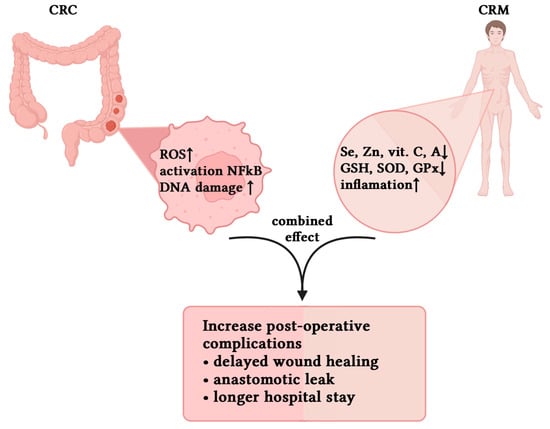
Figure 1
Open AccessArticle
Targeting PON2 with Vutiglabridin Restores Mitochondrial Integrity and Attenuates Oxidative Stress-Induced Senescence
by
Jin-Woong Heo, Hyeong Hwan Kim, Jae Ho Lee, Hyeong Min Lee, Hyung Soon Park and Chang-Hoon Nam
Antioxidants 2025, 14(11), 1288; https://doi.org/10.3390/antiox14111288 - 27 Oct 2025
Abstract
Oxidative stress-induced mitochondrial dysfunction has been identified as a central driver of cellular senescence and age-related degeneration. The present study investigated the potential of vutiglabridin, a paraoxonase 2 (PON2) agonist, to mitigate reactive oxygen species (ROS)-induced senescence in human LO2 hepatocytes. The process
[...] Read more.
Oxidative stress-induced mitochondrial dysfunction has been identified as a central driver of cellular senescence and age-related degeneration. The present study investigated the potential of vutiglabridin, a paraoxonase 2 (PON2) agonist, to mitigate reactive oxygen species (ROS)-induced senescence in human LO2 hepatocytes. The process of senescence was induced by the administration of hydrogen peroxide, followed by the recovery of the cells in fresh medium. The levels of intracellular ROS, the senescence-associated β-galactosidase staining, the p16/p21 expression, and the mitochondrial morphology were the focus of a comprehensive assessment utilizing a range of analytical techniques, including microscopy, quantitative PCR, and Western blotting. The present study demonstrated that the administration of vutiglabridin resulted in a dose-dependent reduction in attenuation of the expression of senescence markers. Transmission electron microscopy (TEM) and stimulated emission depletion (STED) imaging revealed the preservation of mitochondrial structure and network connectivity in cells treated with vutiglabridin. These effects were absent in PON2 knockout cells, confirming that vutiglabridin’s action requires functional PON2. The present study demonstrates that vutiglabridin alleviates oxidative stress-induced cellular senescence by preserving mitochondrial integrity and redox balance via a PON2-dependent mechanism. This study lends further support to the investigation of the PON2 pathway as a therapeutic target in age-related cellular dysfunction.
Full article
(This article belongs to the Special Issue Implication of Oxidative Stress in Promoting Cellular Senescence and Associated Pathologies—2nd Edition)
►▼
Show Figures

Figure 1
Open AccessArticle
Physiological Responses and Serum Metabolite Alterations in Grass Carp (Ctenopharyngodon idellus) Under Chronic Salinity Exposure
by
Xiajie Chen, Bing Li, Yiran Hou, Kepeng Wei, Linjun Zhou, Chengfeng Zhang, Liqiang Zhang, Jian Zhu and Rui Jia
Antioxidants 2025, 14(11), 1287; https://doi.org/10.3390/antiox14111287 - 27 Oct 2025
Abstract
Salinity is a pivotal environmental factor that significantly influences the survival, growth, development, and reproduction of aquatic organisms. However, the characteristics of serum metabolites and their mechanistic roles in mediating the response of grass carp (Ctenopharyngodon idellus) to long-term salinity stress
[...] Read more.
Salinity is a pivotal environmental factor that significantly influences the survival, growth, development, and reproduction of aquatic organisms. However, the characteristics of serum metabolites and their mechanistic roles in mediating the response of grass carp (Ctenopharyngodon idellus) to long-term salinity stress remain incompletely understood. Therefore, the present study exposed grass carp to different salinity levels (0, 4, and 8 g/L) for 60 days to evaluate the associated physiological alterations and metabolic responses. The results revealed that high salinity (8 g/L) significantly suppressed growth performance (p < 0.05), whereas low salinity (4 g/L) caused no significant reduction in growth or survival. Physiological analyses indicated that fish in the 8 g/L group exhibited markedly reduced levels of lactic acid and total protein, along with elevated concentrations of total cholesterol, triglycerides, glucose, and glutamic-oxaloacetic transaminase (p < 0.05). Serum ion homeostasis was also disrupted under high salinity, characterized by increased Ca2+, Na+, and Cl− levels and decreased Mg2+ (p < 0.05). Furthermore, oxidative stress was evident in the high-salinity group through heightened activities of antioxidant enzymes (SOD, CAT, GPx), accumulation of oxidative damage markers (protein carbonyl, 8-OHdG) (p < 0.05). Metabolomic profiling identified 367 and 403 significantly altered metabolites in the 4 g/L and 8 g/L groups, respectively, primarily belonging to lipids and lipid-like molecules along with organic acids and derivatives. KEGG enrichment analysis revealed that these differential metabolites were chiefly involved in amino acid biosynthesis, glycerophospholipid metabolism, biosynthesis of unsaturated fatty acids, and glycine, serine, and threonine metabolism. Trend analysis further uncovered eight distinct expression patterns of metabolites across salinity gradients. These results provide novel insights into the metabolic adaptations of grass carp to salinity stress, demonstrating that high salinity induces oxidative stress, disrupts ion regulation, and drives extensive metabolic reprogramming. The study offers valuable theoretical support for improving salinity tolerance management in aquaculture and informs the selective breeding of salt-tolerant fish strains.
Full article
(This article belongs to the Special Issue Antioxidant Response in Aquatic Animals)
►▼
Show Figures

Figure 1
Open AccessReview
Redox Control in Platelet Activity and Therapy
by
Laura M. Dionisio, Yi Zheng and Jose A. Cancelas
Antioxidants 2025, 14(11), 1286; https://doi.org/10.3390/antiox14111286 - 27 Oct 2025
Abstract
Maintaining redox balance is essential for platelet physiology and overall cellular homeostasis. Upon activation, platelets generate reactive oxygen species (ROS), which act as signaling mediators in responses to collagen and are required for collagen-dependent thrombus formation. Multiple enzymatic systems contribute to platelet ROS
[...] Read more.
Maintaining redox balance is essential for platelet physiology and overall cellular homeostasis. Upon activation, platelets generate reactive oxygen species (ROS), which act as signaling mediators in responses to collagen and are required for collagen-dependent thrombus formation. Multiple enzymatic systems contribute to platelet ROS production, with nicotinamide adenine dinucleotide (phosphate) oxidases (NOX isoforms) serving as the primary source, complemented by cyclooxygenase (COX), xanthine oxidase (XO), and the mitochondrial respiratory chain. Both oxidative and reductive stress disrupt this equilibrium and have been implicated in the pathophysiology of diverse diseases, including bleeding disorders, thrombosis, cardiovascular disorders, diabetes and cancer. In transfusion medicine, mitochondrial dysfunction and the resulting oxidative stress are key drivers of platelet lesion resulting in clearance defects and the progressive loss of hemostatic activity during storage. Targeting platelet-specific redox regulatory pathways represents a promising strategy to better define platelet contributions to human health and to develop interventions that may alter disease outcomes in which platelets play a central role.
Full article
(This article belongs to the Special Issue Blood Cells and Redox Homeostasis in Health and Disease, 2nd Edition)
►▼
Show Figures
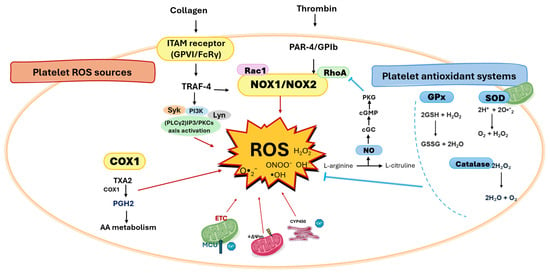
Figure 1
Open AccessArticle
Evaluation of Oxidative Stress Markers in Post-Surgical Head and Neck Cancer Patients Rehabilitated with Removable Prosthetic Restorations
by
Beata Sawczuk, Elżbieta Supruniuk, Ewa Żebrowska, Suresh Nayar, Adrian Chabowski and Teresa Sierpińska
Antioxidants 2025, 14(11), 1285; https://doi.org/10.3390/antiox14111285 - 27 Oct 2025
Abstract
The effects of free radicals and chronic oxidative stress are the cause of many diseases, including those of the oral cavity, among which the most important are inflammatory processes and cancer. For this reason, an important element of the body’s defense is maintaining
[...] Read more.
The effects of free radicals and chronic oxidative stress are the cause of many diseases, including those of the oral cavity, among which the most important are inflammatory processes and cancer. For this reason, an important element of the body’s defense is maintaining proper antioxidant activity. Study aim: To assess oxidative stress parameters in the saliva of patients using removable prostheses after head and neck cancer surgery. Material and methods: 44 oncological patients operated on for head and neck cancer and 20 healthy edentulous volunteers as a control group. Removable acrylic dentures were prepared for both groups. The material for oxidative stress analysis was saliva: non-stimulated saliva (NWS) and stimulated saliva (SW) after 3 months of prosthetic treatment. Results: Changes in the level of oxidative stress parameters were observed in the study group after 3 months of prosthetic treatment. Specifically, we observed a higher level of deoxyribonucleic acid (DNA)/ribonucleic acid (RNA) damage in oncology patients compared to controls. The levels of protein oxidation products—protein carbonyls, lipid peroxidation products, malondialdehyde (MDA), and nitrotyrosine—were slightly higher in the study group in all measurements. Conclusion: Based on this study, it was found that removable prostheses have a minor impact on the level of enzymatic and non-enzymatic oxidative stress parameters. This research suggests an adaptation to prosthetic restorations that results in almost restored redox balance.
Full article
(This article belongs to the Section ROS, RNS and RSS)
►▼
Show Figures

Figure 1
Open AccessArticle
Allobaculum mucilyticum-Mediated Gut Barrier Dysfunction Exacerbates the Severity of Hypertriglyceridemic Acute Pancreatitis in Mice
by
Ping Yang, Meirong Wu, Wenjie Liang, Yudong Sun, Li-Long Pan and Jia Sun
Antioxidants 2025, 14(11), 1284; https://doi.org/10.3390/antiox14111284 - 27 Oct 2025
Abstract
Hypertriglyceridemic acute pancreatitis (HTGAP) is characterized by frequent severe complications and poor clinical prognosis. Recent evidence suggests that gut dysbiosis is correlated with pancreatic injury in HTGAP, although the precise mechanisms remain to be elucidated. Here, we found that experimental HTGAP mice exhibited
[...] Read more.
Hypertriglyceridemic acute pancreatitis (HTGAP) is characterized by frequent severe complications and poor clinical prognosis. Recent evidence suggests that gut dysbiosis is correlated with pancreatic injury in HTGAP, although the precise mechanisms remain to be elucidated. Here, we found that experimental HTGAP mice exhibited gut dysbiosis and intestinal barrier dysfunction, accompanied by an abnormal increase in Allobaculum mucilyticum (A. mucilyticum) and a decrease in Akkermansia muciniphila (A. muciniphila). Administration of A. mucilyticum aggravated oxidative stress-associated intestinal barrier dysfunction, promoted bacterial translocation to the pancreas, and ultimately exacerbated pancreatic injury. Conversely, supplementation with A. muciniphila alleviated the severity of HTGAP by restoring mucus layer thickness and reducing intestinal pro-inflammatory macrophage polarization. These findings highlight the critical role of gut dysbiosis in HTGAP progression, mediated through the pro-inflammatory mucolytic pathobiont A. mucilyticum, and suggest that modulating gut microbiota may represent a novel therapeutic strategy for HTGAP.
Full article
(This article belongs to the Section Health Outcomes of Antioxidants and Oxidative Stress)
►▼
Show Figures

Graphical abstract
Open AccessArticle
miR-26a-Targeting SLC7A11 Regulates Erastin-Induced Granulosa Cell Ferroptosis
by
Xue Zhao, Yuheng Pan, Shuang Liang, Yuhang Lei, Yan Wang, Lei Chen, Ye Zhao, Mailin Gan, Linyuan Shen, Xin Yang and Li Zhu
Antioxidants 2025, 14(11), 1283; https://doi.org/10.3390/antiox14111283 - 26 Oct 2025
Abstract
Granulosa cell ferroptosis is a critical factor in follicular atresia and premature ovarian insufficiency (POI). As a regulated form of programmed cell death, ferroptosis is gaining significant attention in reproductive medicine research. MicroRNAs (miRNAs) play a crucial role in regulating key aspects of
[...] Read more.
Granulosa cell ferroptosis is a critical factor in follicular atresia and premature ovarian insufficiency (POI). As a regulated form of programmed cell death, ferroptosis is gaining significant attention in reproductive medicine research. MicroRNAs (miRNAs) play a crucial role in regulating key aspects of ferroptosis, including the glutathione-GPX4 pathway, glutamate/cystine transport, and iron and lipid metabolism. The present study demonstrates that miR-26a positively modulates ferroptosis by targeting SLC7A11, a member of the solute carrier family. We found that oocytes and granulosa cells are susceptible to the ferroptosis inducer erastin, and employed RNA sequencing to delineate the miRNA expression profiles during erastin-induced damage and ferroptosis. Notably, miR-26a expression was significantly upregulated in erastin-treated oocytes. Importantly, overexpression of miR-26a promoted ferroptosis in granulosa cells, while its knockdown inhibited this process. Ectopic miR-26a expression suppressed SLC7A11, thereby increasing ferroptosis. Our findings indicate that miR-26a influences ferroptosis by inhibiting glutathione synthesis, reducing cellular antioxidant capacity, and suggesting a potential strategy to enhance reproductive potential.
Full article
(This article belongs to the Special Issue Recent Advances in Applications of Antioxidants in Livestock Health and Reproduction)
►▼
Show Figures

Figure 1

Journal Menu
► ▼ Journal Menu-
- Antioxidants Home
- Aims & Scope
- Editorial Board
- Reviewer Board
- Topical Advisory Panel
- Instructions for Authors
- Special Issues
- Topics
- Sections & Collections
- Article Processing Charge
- Indexing & Archiving
- Editor’s Choice Articles
- Most Cited & Viewed
- Journal Statistics
- Journal History
- Journal Awards
- Society Collaborations
- Conferences
- Editorial Office
Journal Browser
► ▼ Journal BrowserHighly Accessed Articles
Latest Books
E-Mail Alert
News
Topics
Topic in
Analytica, Antioxidants, Applied Sciences, Molecules, Separations, Marine Drugs, Pharmaceuticals
New Analytical Methods in Plant Active Components Analysis
Topic Editors: Filomena Lelario, Giuliana Bianco, Radosław KowalskiDeadline: 31 October 2025
Topic in
Biomolecules, Cancers, IJMS, Nutrients, Antioxidants
Advances in Adiponectin
Topic Editors: Puran S. Bora, Mayank ChoubeyDeadline: 24 November 2025
Topic in
Antioxidants, Chemistry, IJMS, Molecules, Pharmaceutics
Natural Bioactive Compounds as a Promising Approach to Mitigating Oxidative Stress
Topic Editors: Andrea Ragusa, Filomena CorboDeadline: 31 December 2025
Topic in
Antioxidants, Cancers, Gastroenterology Insights, Life, Nutrients
Oxidative Stress and Diet: The Health Implications of Advanced Glycation and Lipid Oxidation End-Products
Topic Editors: Joseph Kanner, Ron KohenDeadline: 31 March 2026

Conferences
Special Issues
Special Issue in
Antioxidants
Antioxidant Peptides
Guest Editors: Daniel Carneiro Moreira, José Roberto de Souza de Almeida LeiteDeadline: 30 October 2025
Special Issue in
Antioxidants
Oxidative Stress and Liver Disease
Guest Editor: Alejandra EscalonaDeadline: 31 October 2025
Special Issue in
Antioxidants
Reactive Oxygen Species and Growth Factors in Photodynamic Therapy (PDT), Photobiomodulation (PBM), and Radiation Therapy (RT)
Guest Editors: Timothy C. Zhu, Brian WilsonDeadline: 31 October 2025
Special Issue in
Antioxidants
Antioxidant Role of High-Density Lipoprotein
Guest Editor: Paul DurringtonDeadline: 31 October 2025
Topical Collections
Topical Collection in
Antioxidants
Advances in Antioxidant Ingredients from Natural Products
Collection Editors: Carla Susana Correia Pereira, Lillian Barros



